Generalized linear mixed model fit by maximum likelihood (Laplace
Approximation) [glmerMod]
Family: binomial ( logit )
Formula: DV ~ sc(FvO) * sc(EvC) + (1 | Code) + (0 + (sc(FvO) * sc(EvC)) |
Code) + (1 | Item)
Data: feminine
Control: glmerControl(optimizer = "bobyqa")
AIC BIC logLik deviance df.resid
879.3 943.6 -427.7 855.3 1558
...
Fixed effects:
Estimate Std. Error z value Pr(>|z|)
(Intercept) -1.0566 1.1485 -0.92 0.35758
sc(FvO) 1.2453 0.3505 3.55 0.00038 ***
sc(EvC) -0.0915 0.3080 -0.30 0.76638
sc(FvO):sc(EvC) 0.0221 0.6321 0.04 0.97207
---
Signif. codes: 0 '***' 0.001 '**' 0.01 '*' 0.05 '.' 0.1 ' ' 1
...Introductions to R and Statistics
Univariate Statistics and Methodology using R
Psychology, PPLS
University of Edinburgh
Hello
Jack Archer
Em Bolton
Martin Corley
Greta Gandolfi
Josiah King
Elva Peng
Irene Winther

Five Things to Do
watch the introductory lecture on Learn
find piazza on Learn, and introduce yourself
get the software (or check that rstudio.ppls.ed.ac.uk works for you)
fill in the survey at edin.ac/3B0oi5A
check what lab you’re in (bring a charged laptop if possible)
Why R?
What is R?

R is a ‘statistical programming language’
created mid-90s as a free version of S
widespread adoption since v2 (2004)
RStudio is an ‘integrated development environment’ (IDE)
created 2011 ‘to improve R experience’
widespread adoption since 2012

R vs RStudio
This is R
This is RStudio
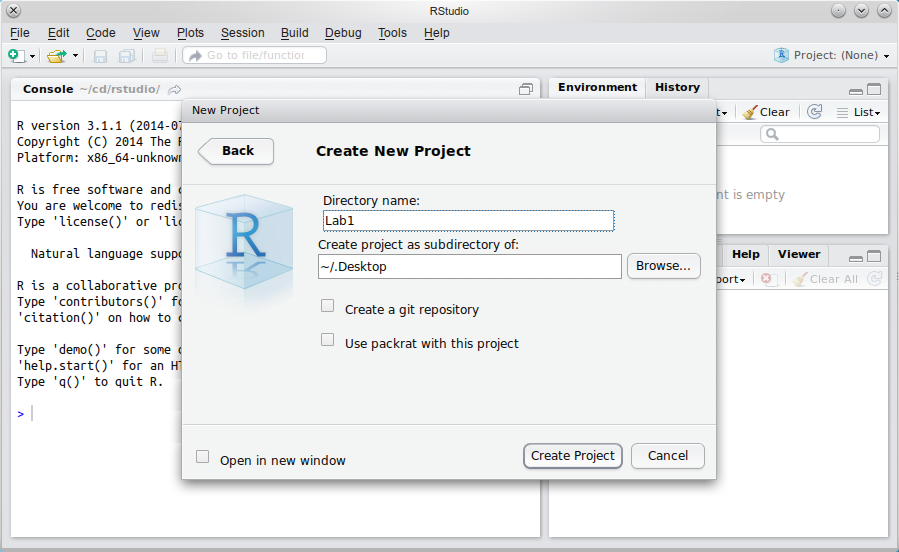
RMarkdown

RMarkdown is a ‘text markup language’
created 2012 as a markup language for R
widespread adoption since 2015
Quarto is the latest-and-greatest RMarkdown version
the one to learn if you want to get serious

RMarkdown
### About RMarkdown
_This_ is some **RMarkdown**, which uses 'simple' codes to mark up text.
- it can include R code like `r sqrt(2)`
- it's simple to format things like bulleted lists
+ or even sublistsAbout RMarkdown
This is some RMarkdown, which uses ‘simple’ codes to mark up text.
- it can include R code like 1.4142
- it’s simple to format things like bulleted lists
- or even sublists
What is R Good For?
Managing Datasets
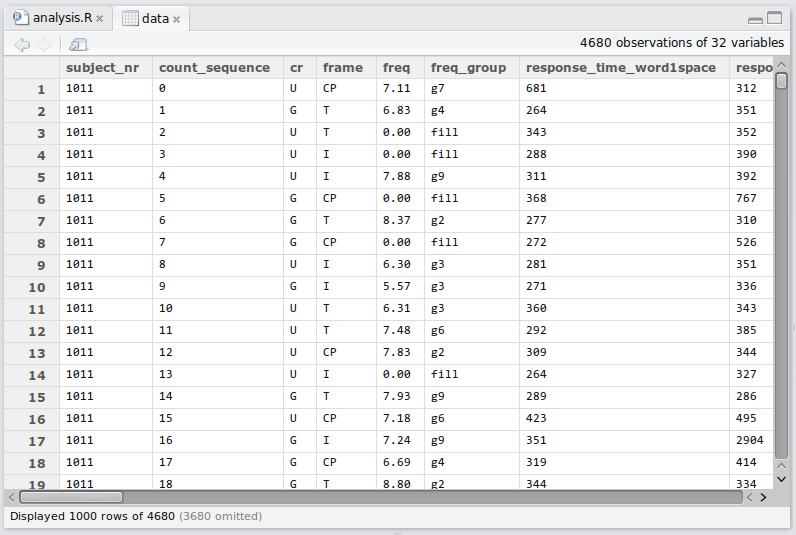
Doing Statistics
Publication-Quality Graphics
Data Visualisation

RMarkdown: Books
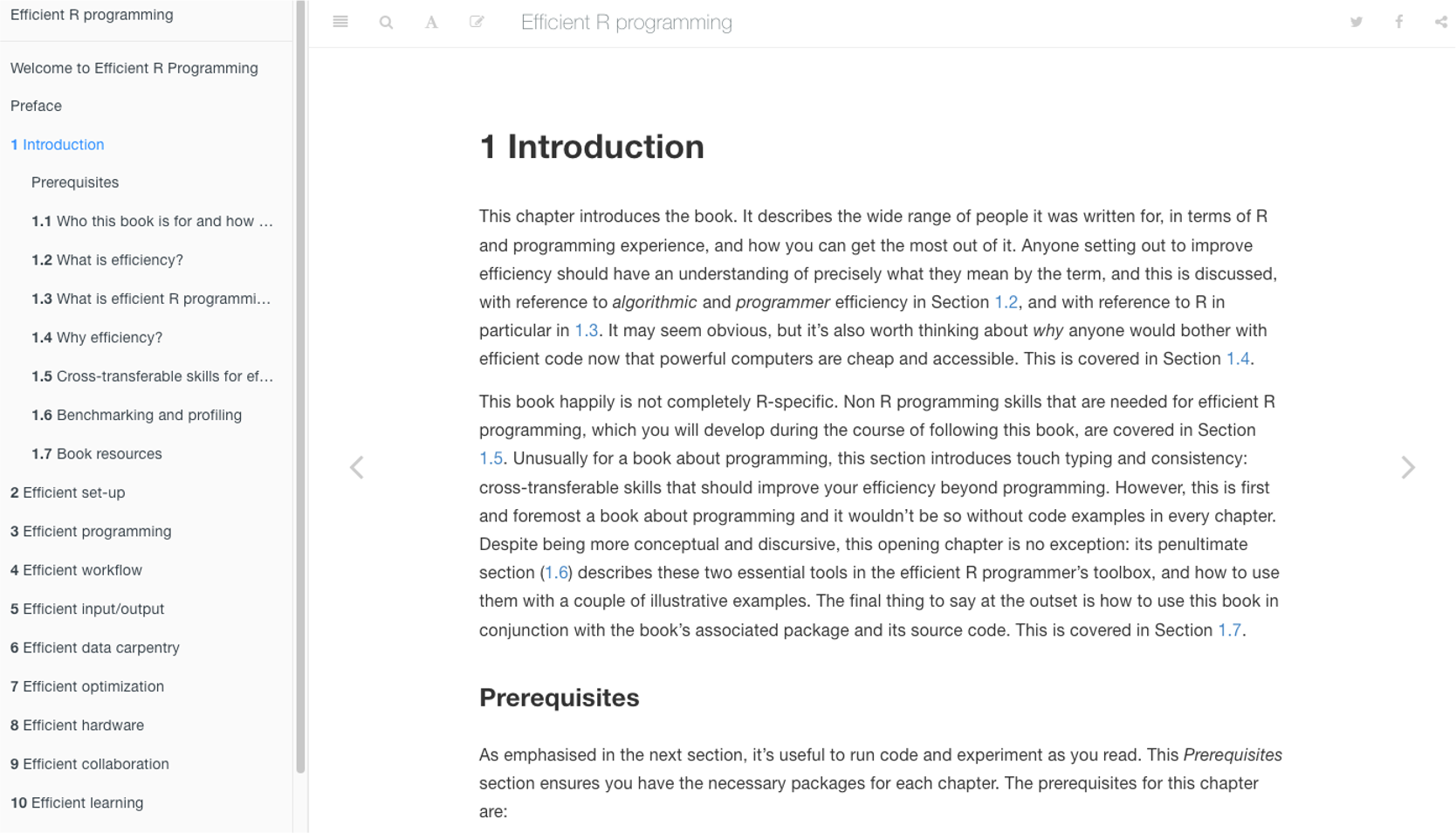
RMarkdown: Websites

Online Interactive Visualisation
R for Anything to do with Data
require(tm)
require(wordcloud)
pp <- Corpus(DirSource("R/PP/"))
pp <- tm_map(pp, stripWhitespace)
pp <- tm_map(pp, tolower)
pp <- tm_map(pp, removeWords,
stopwords("english"))
pp <- tm_map(pp, stemDocument)
pp <- tm_map(pp, removePunctuation)
pp <- tm_map(pp, PlainTextDocument)
wordcloud(pp, scale = c(5,
0.5), max.words = 150,
random.order = FALSE,
rot.per = 0.35, colors = brewer.pal(12,
"Dark2"))The R Community
- someone else has done all the hard work to create wordclouds
- released as libraries or packages (like
lme4andtidyverse) - all I supplied was a text version of Pride and Prejudice
- R allows you to do anything with data
- if it’s useful, chances are someone has already done it
- useful things include statistics!
The R Community
- if it’s useless, chances are that someone’s already done it

- USMR is created in RStudio, using R and RMarkdown
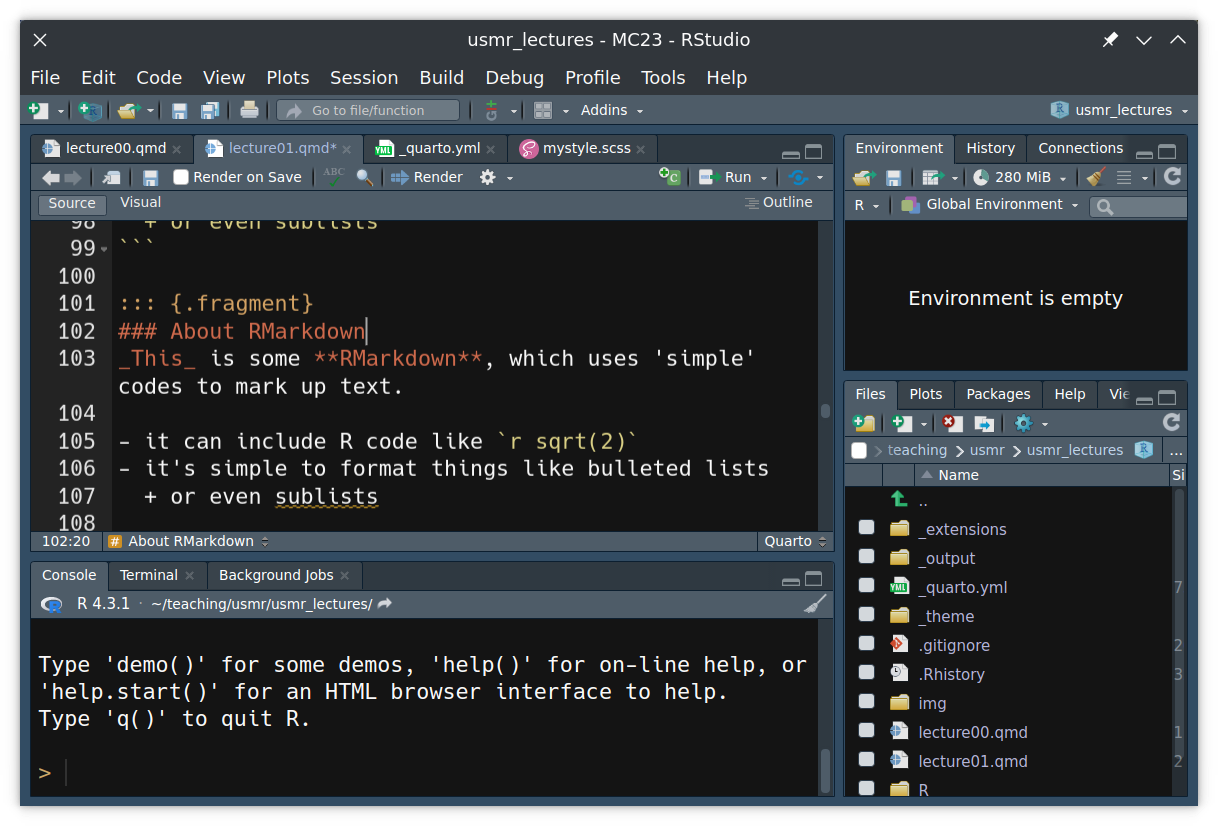
Why Use R?
because it’s a language, I can easily show you what I did and you can copy it
because it’s a language, statisticians can use it to implement leading-edge stats
because it’s free, anyone can use it—and anyone can access your research
because it’s open source, anyone can fix or improve it
Devilish Stuff
doing stats
coding

![]() Notes for Wizards
Notes for Wizards
did you notice my hat on the last slide?
it marks something that’s good to know but you don’t need to know (yet)
“notes for wizards” (of all genders and none!)

Basics of R
Data in R
- you can type data directly in to R
Variables
Statistics is about Groups
Not everything is a number
Basic types of data (stats)
Nominal
(‘names of things’: e.g., hair colour)
Ordinal
(order, no number: e.g., small-medium-large)
Interval
(number without a true zero: e.g., body temp in ℃)
Ratio
(number with a true zero: e.g., height)

NOIR in R
Break it down
allHair
- variable (we chose the name
allHair)
<-
- assignment (“goes in to”)
c()
- function (
c()combines its arguments)
"brown"
- character (arbitrary sequence of symbols)
Dataframes
- data can be grouped into a dataframe
- each line represents one set of observations
- each column represents one type of information
- (a bit like a spreadsheet)
Functions and dataframes
- you can run a function on a dataframe
We know a little about R
we’ve seen some R code
we know about basic data types
we know what variables are
we’ve seen vectors, and dataframes
we’ve seen a couple of examples of functions
Dice
How likely are you to throw 12?
pretty easy to work out
one-in-six chance of throwing a six
one-in-six chance of throwing a second six
- NB., these observations are independent
- (wouldn’t matter if you threw one dice twice or two dice together)
\(\frac{1}{36}\) chance of throwing two sixes
Are my dice fair?
- throw two dice many times and count the outcomes
What would fair dice look like?

we need a lot of throws
first rule of coding: be lazy
let the computer do the work
Using RStudio
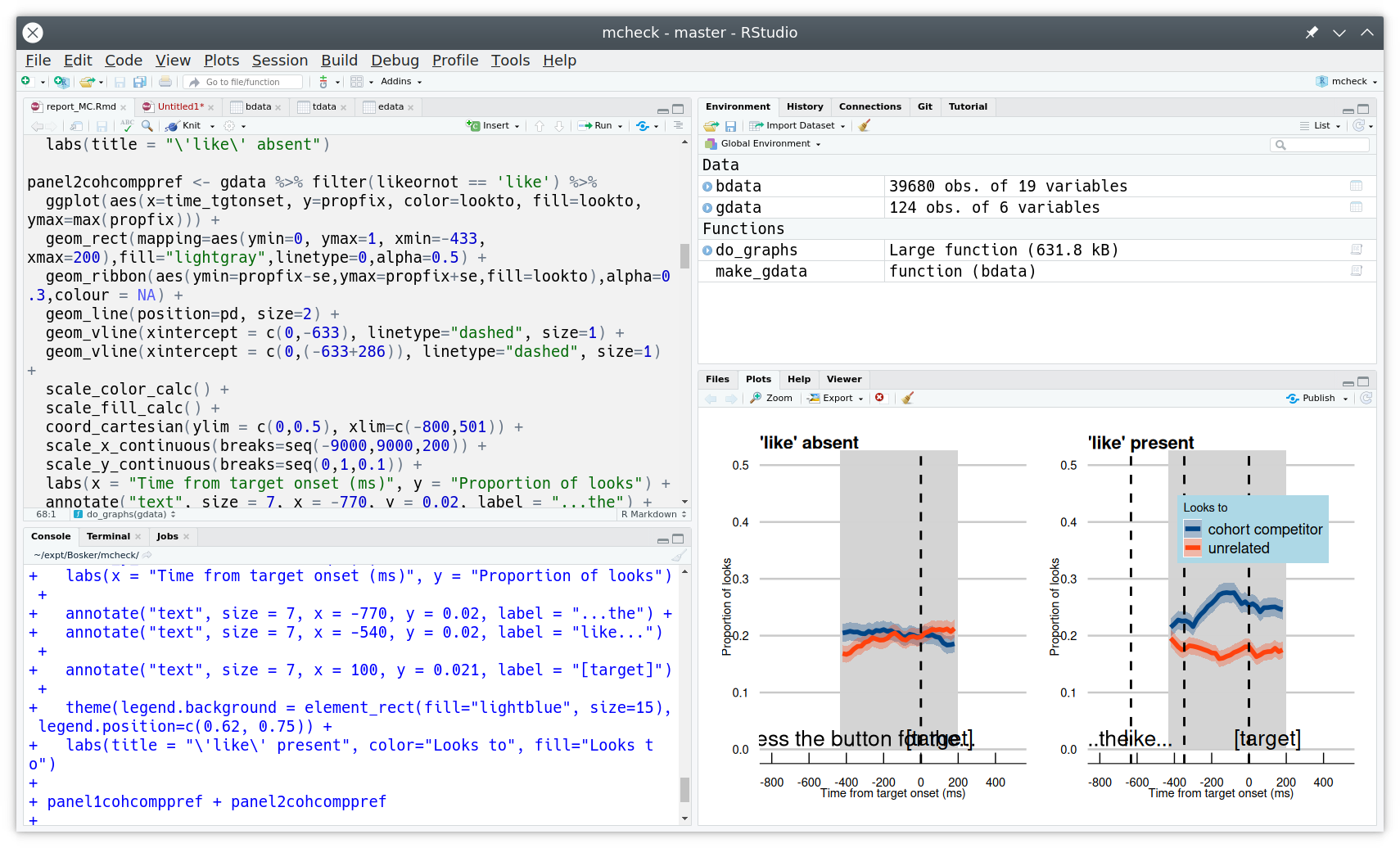
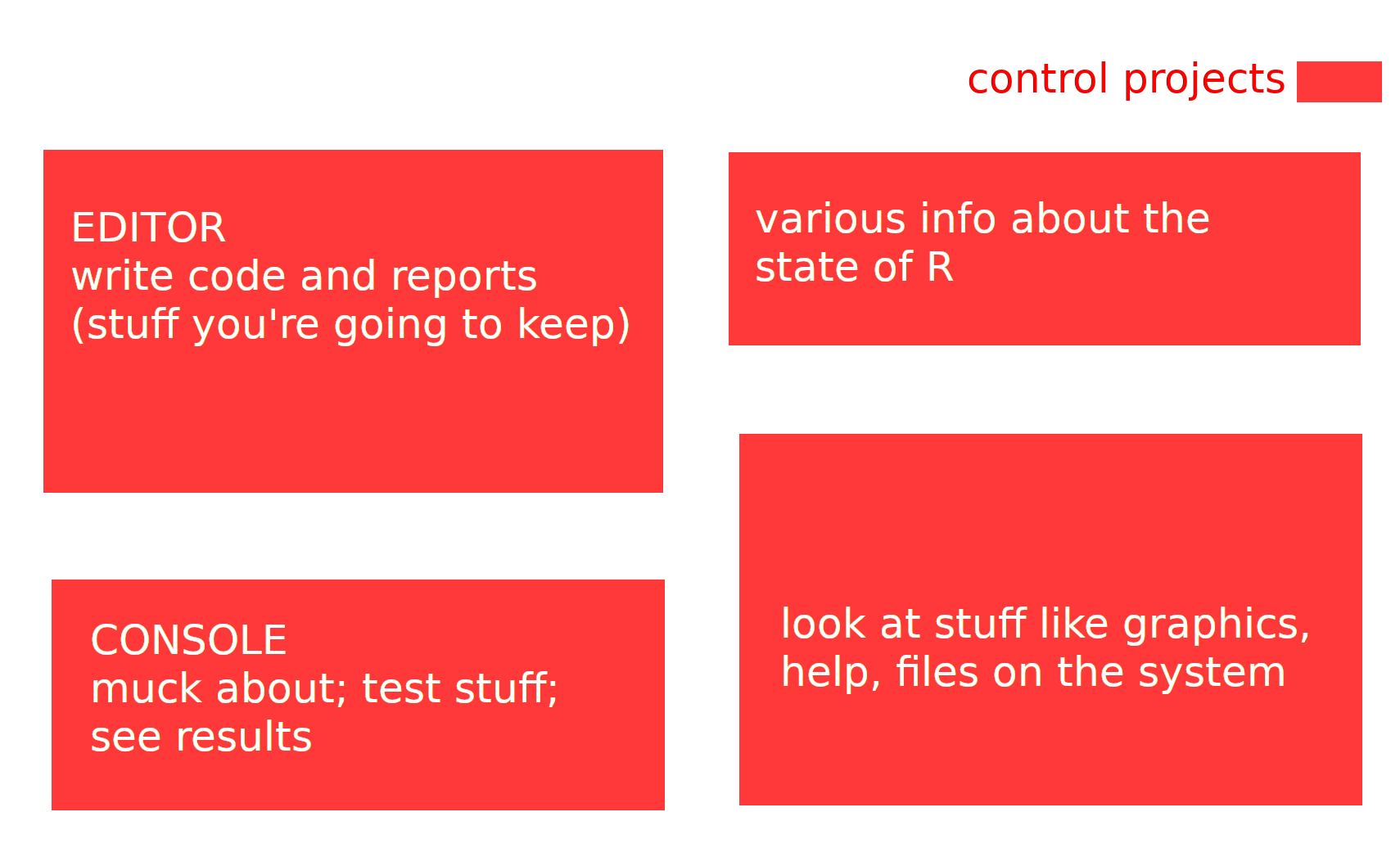
create some dice
Throwing dice many times
Throwing dice many times
Throwing dice many times
- try the function
Throw two dice many times
[1] 7 8 5 8 6 7 12 8 11 12 8 5 7 7 3 3 12 8 4 8 11 6 11 5 4
[26] 10 8 3 7 4 9 4 11 10 10 6 4 12 4 8 10 6 6 7 12 9 6 10 2 7
[51] 8 8 6 7 8 10 10 3 3 5 5 3 7 5 5 8 9 11 5 6 8 3 5 10 6
[76] 4 6 3 6 5 4 9 5 7 12 7 9 5 7 8 3 2 9 7 9 10 8 4 6 9
[101] 7 8 2 10 12 9 6 5 10 10 10 2 4 10 6 2 6 11 7 6 9 8 4 7 9
[126] 12 7 6 3 2 5 7 6 10 4 10 2 12 10 8 5 10 6 9 8 6 9 8 11 7
[151] 9 8 3 6 8 6 10 8 11 11 8 10 3 10 7 6 10 7 5 9 10 7 12 9 8
[176] 5 8 5 8 3 12 6 11 7 8 9 7 5 8 7 3 10 6 6 7 6 8 12 6 4
[201] 11 10 11 7 5 5 5 7 6 6 2 12 4 6 9 11 7 5 12 4 8 10 8 10 8
[226] 10 8 8 4 9 12 5 4 10 6 6 7 10 9 8 10 5 4 7 5 5 11 8 7 5… and record the result
Make a table
Make a graph
Many more throws
10,000 dice throws
- seems fairly satisfactory?
Some more (fake) dice throws
for these dice 12 is thrown 421 times (expected: 277.8)
are the patterns from the dice different enough from what we would expect from fair dice?
Statistical questions
- so the million-dollar question is a negative question
are we dissatisfied with the suggestion that the pattern of results we have observed should be attributed to chance?
if we are, then maybe we can persuade you of a different explanation
but note that the different explanation is not proven, it’s suggested
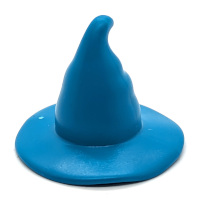 Notes for Wizards
Notes for Wizards